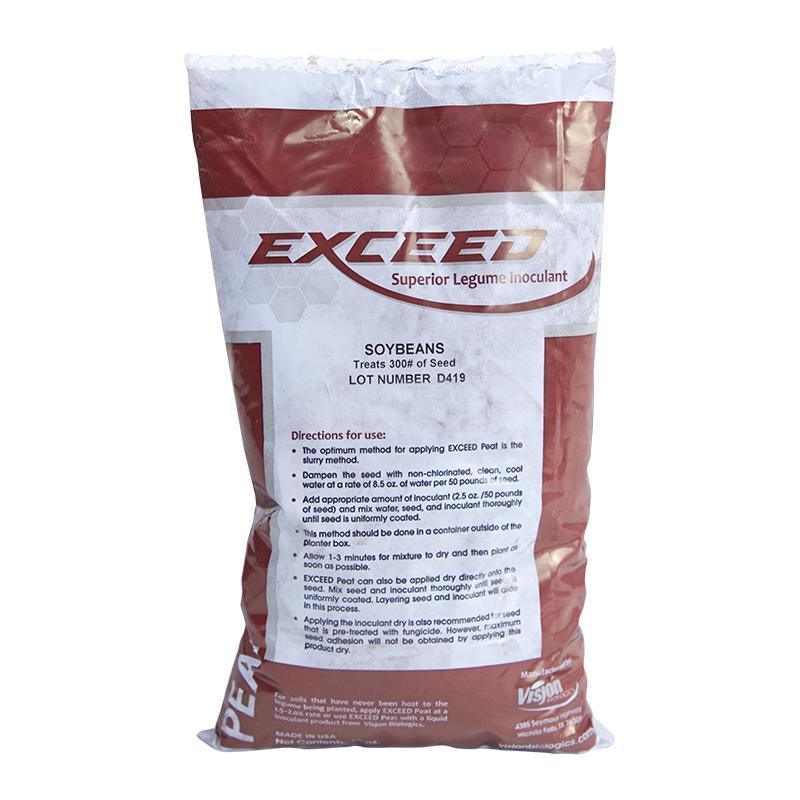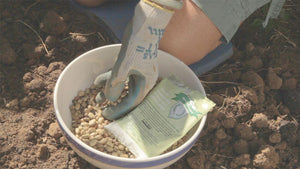Item Number: ISE555
Soybean Inoculant (Treats 300 lb)
Inoculate Your Soybeans for Increased Soil Nitrogen
Contains peat-based inoculant products containing live culture of nitrogen-fixing Rhizobium bacteria. Treats up to 300 lbs. of soybeans.
Directions for Application:
- Dampen seeds with non-chlorinated, clean, cool water.
- Add just enough inoculant to uniformly coat the seeds. This is quite a dusty step, it is advised to wear a dust mask.
- Allow 1-3 minutes for the mixture to dry and then plant seed as soon as possible.
Store product in a cool, dry place out of direct sunlight. Store between 40 and 77°F.
Introduction to Soybean Inoculant
Soybean inoculant is a valuable agricultural product designed to enhance soybean crop production. It is a biological agent containing beneficial rhizobia bacteria, specifically formulated to improve nitrogen fixation in soybean plants. This essential process helps maximize soybean yield by increasing the availability of nitrogen in the soil.
The Importance of Soybean Inoculant
Soybeans, like many leguminous crops, have a unique ability to form a symbiotic relationship with rhizobia bacteria, found in the root nodules of the plant. These bacteria have the capability to fix atmospheric nitrogen into a form that soybeans can readily utilize. Nitrogen is a crucial nutrient required for plant growth and development. However, soybean plants cannot utilize atmospheric nitrogen directly, and they heavily rely on the presence of rhizobia bacteria to convert it into a usable form.
By using soybean inoculant, farmers can introduce a specific strain of rhizobia bacteria to their fields, ensuring a healthy symbiotic relationship between the bacteria and the soybean plants. This enhanced nitrogen fixation ultimately results in increased soybean yields, improved crop quality, and reduced reliance on synthetic nitrogen fertilizers.
How to Use Soybean Inoculant
Using soybean inoculant is a straightforward process. Here are the steps to effectively apply it to your soybean seeds:
Select the Right Inoculant: Choose a soybean inoculant product that is compatible with the soybean variety you intend to plant. Different strains of rhizobia bacteria may be needed for different soybean cultivars, so it is essential to use the appropriate product.
Prepare the Seeds: Before applying the inoculant, ensure that your soybean seeds are clean and dry. Any moisture on the seeds can inhibit the effectiveness of the inoculant.
Mix with Inoculant: In a separate container, mix the soybean seeds with the inoculant powder or liquid according to the recommended dosage. Manufacturers provide guidelines on the appropriate amount to use.
Coat the Seeds: Thoroughly coat the soybean seeds with the inoculant mixture. Ensure that all seeds are evenly covered to promote uniform bacterial colonization.
Plant the Seeds: Plant the inoculated seeds immediately after the application, following standard planting depth and spacing guidelines for soybeans.
Moisture and Temperature: Adequate soil moisture and temperature are crucial for the establishment of the rhizobia bacteria in the root nodules. Proper environmental conditions will allow for efficient nitrogen fixation.
Monitor Crop Growth: Keep an eye on your soybean crop's growth and health throughout the season. Healthy plants with a well-established symbiotic relationship with rhizobia bacteria will exhibit improved nitrogen-fixing capabilities.
Types of Seeds Compatible with Soybean Inoculant
Soybean inoculant is primarily used with soybean seeds, specifically Glycine max. While it is specifically designed for soybeans, other leguminous crops like various bean varieties, peas, and lentils can also benefit from inoculation with compatible strains of rhizobia bacteria. However, it is essential to use the appropriate inoculant formulation for each specific crop type to ensure optimal results.
Soybean inoculant is a valuable tool for farmers looking to improve soybean crop yields and reduce their reliance on synthetic fertilizers. By enhancing the nitrogen-fixing capabilities of soybean plants through a symbiotic relationship with rhizobia bacteria, growers can achieve healthier and more productive soybean crops. When used correctly, soybean inoculant is a cost-effective and environmentally friendly solution to boost soybean production and contribute to sustainable agriculture.

Check Your Zone Compatibility:
Compatible with your zone.
Growing Zone for

Our Guarantee To You
Since 1976, we've served our customers at every stage of growing. Please contact us at any time. We are happy to support and assist you.
Shipping Information
Shipping Information
Shipping Weight: 1.5 lb
Dimensions: 8.75"L x 5.0"W x 0.25"H
Features
Features
Characteristics
Characteristics
Use Instructions
Use Instructions
Useful Information
Useful Information
Guarantee
Guarantee
Share



